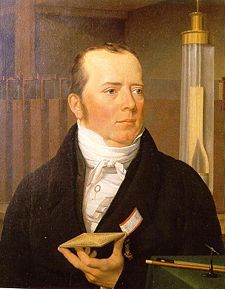Hans Christian Ørsted
| Hans Christian Ørsted | |
 |
|
| Born | 14 August 1777 Rudkøbing, Denmark |
|---|---|
| Died | 9 March 1851 (aged 73) Copenhagen, Denmark |
| Fields | physics chemistry |
| Known for | electromagnetism |
Hans Christian Ørsted (14 August 1777 – 9 March 1851) was a Danish physicist and chemist. He shaped post-Kantian philosophy and advances in science throughout the late nineteenth century.[1] He is best known for discovering the relationship between electricity and magnetism known as electromagnetism. He was also the first modern thinker to explicitly describe and name the thought experiment.
Contents |
Early life and studies
Ørsted developed his interest in science while working as a young boy for his father, Søren Christian Ørsted, who owned a pharmacy. He and his brother, Anders Sandøe Ørsted, received most of their early education through self-study at home, leaving home for Copenhagen in 1793 to take entrance exams for the University of Copenhagen. The brothers passed and distinguished themselves academically at the University. By 1796, Ørsted received honours for his papers in both aesthetics and physics.
In 1801, Hans received a travel scholarship and public grant that enabled him to spend three years traveling in Europe. In Germany, he met Johann Wilhelm Ritter, a physicist who believed there was a connection between electricity and magnetism. The connection made sense to Ørsted since he believed in the unity of nature, and, therefore, that a relationship must exist between most natural phenomena.
Their conversations drew Ørsted into the study of physics. He became a professor at the University of Copenhagen in 1806 and continued his research with electric currents and acoustics. Under his guidance, the University developed a comprehensive physics and chemistry program and established new laboratories.
Electromagnetism

While preparing for an evening lecture on 21 April 1820, Ørsted developed an experiment which provided evidence that surprised him. As he was setting up his materials, he noticed a compass needle deflected from magnetic north when the electric current from the battery he was using was switched on and off. This deflection convinced him that magnetic fields radiate from all sides of a wire carrying an electric current, just as light and heat do, and that it confirmed a direct relationship between electricity and magnetism.
At the time of discovery, Ørsted did not suggest any satisfactory explanation of the phenomenon, nor did he try to represent the phenomenon in a mathematical framework. However, three months later he began more intensive investigations. Soon thereafter he published his findings, proving that an electric current produces a magnetic field as it flows through a wire. The CGS unit of magnetic induction (oersted) is named in honor of his contributions to the field of electromagnetism.
His findings resulted in intensive research throughout the scientific community in electrodynamics. The findings influenced French physicist André-Marie Ampère's developments of a single mathematical form to represent the magnetic forces between current-carrying conductors. Ørsted's discovery also represented a major step toward a unified concept of energy.
Aluminium
In 1825, Ørsted made a significant contribution to chemistry by producing aluminium for the first time.
Poetry
Ørsted was also a published writer and poet. His poetry series Luftskibet ("Airship") was inspired by the balloon flights of fellow physicist and stage magician Étienne-Gaspard Robert.[2]
Death and legacy
Ørsted died in 1851, and was buried in the Assistens Cemetery in Copenhagen.
The 100 danske kroner note issued from 1950 to 1970 features an engraving of Ørsted.
Today, the buildings which are home to the Department of Chemistry and the Institute for Mathematical Sciences at the University of Copenhagen, are named The H.C. Ørsted Institute in his honor. Also, the first Danish satellite, launched 1999, was named Ørsted in his honor.
See also
- James Clerk Maxwell
- Thought experiment
References
- ↑ Brian, R.M. & Cohen, R.S. (2007). Hans Christian Ørsted and the Romantic Legacy in Science, Boston Studies in the Philosophy of Science, Vol. 241.
- ↑ National Museum of Denmark. "The Soul in Nature: 1802". Accessed 30 July 2007.
-
- Dibner, Bern, Oersted and the discovery of electromagnetism, New York, Blaisdell (1962).
- Ole Immanuel Franksen, H. C. Ørsted - a man of the two cultures, Strandbergs Forlag, Birkerød, Denmark (1981). (Note: Both the original Latin version and the English translation of his 1820 paper "Experiments on the effect of a current of electricity on the magnetic needle" can be found in this book.)
| Awards | ||
|---|---|---|
| Preceded by Robert Seppings |
Copley Medal 1820 |
Succeeded by Edward Sabine and John Herschel |
External links
- Interactive Java Tutorial on Oersted's Compass Experiment National High Magnetic Field Laboratory
| Persondata | |
|---|---|
| NAME | Ørsted, Hans Christian |
| ALTERNATIVE NAMES | |
| SHORT DESCRIPTION | Danish physicist and chemist |
| DATE OF BIRTH | 14 August 1777 |
| PLACE OF BIRTH | Rudkøbing, Denmark |
| DATE OF DEATH | 9 March 1851 |
| PLACE OF DEATH | Copenhagen, Denmark |